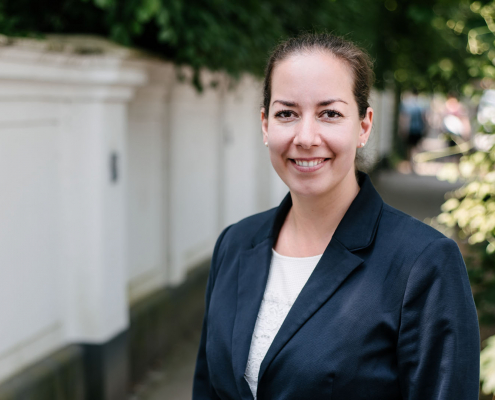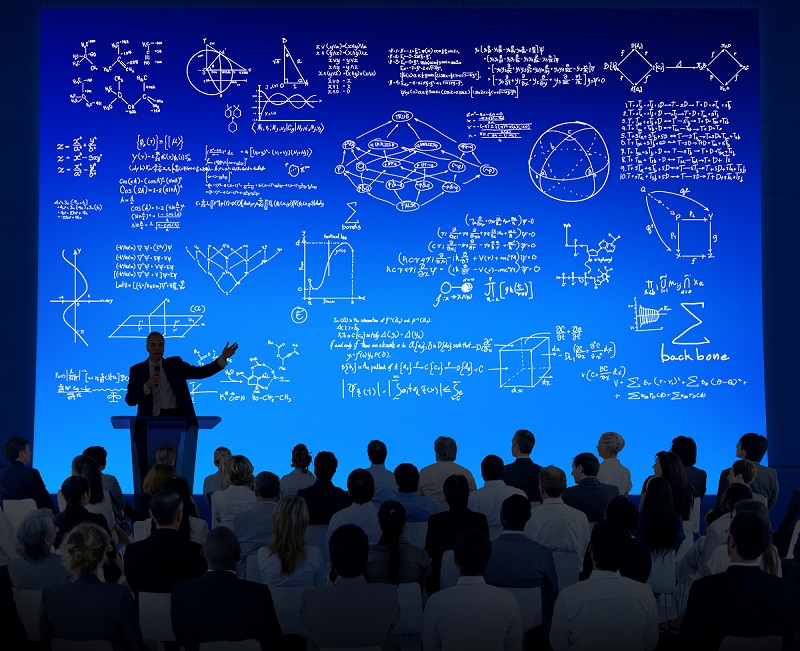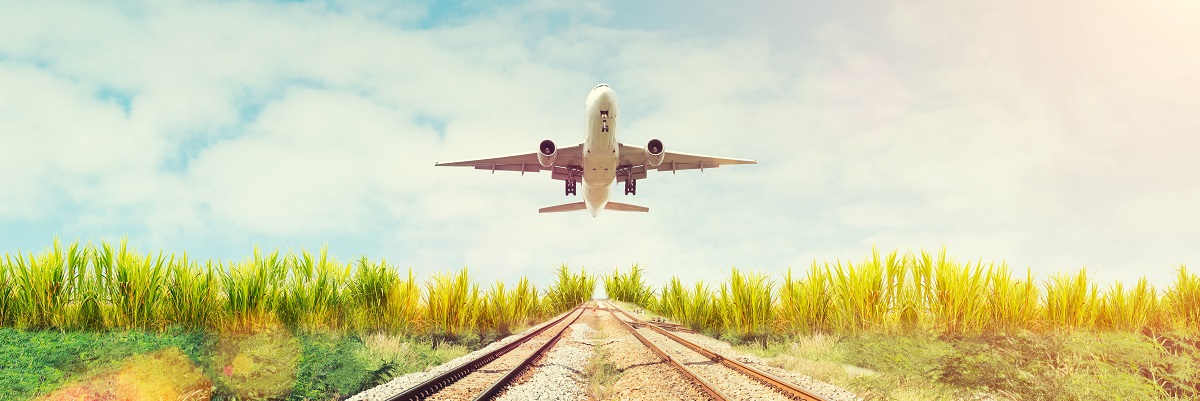“A Transition to Climate Sustainability Requires a Change in Culture in Science”

Astrid Eichhorn is chairing the ALLEA Working Group on Climate Sustainability in the Academic System. Credit: Sebastian Neumann/Latest Thinking
Climate sustainability in academia is emerging as a pending, urgent task for all research institutions and individuals. How can science reduce its own emissions without compromising excellence and international collaboration? Can the academia travel culture be re-examined and transformed into a more sustainable model?
Astrid Eichhorn is an Associate Professor at the Centre for Cosmology and Particle Physics Phenomenology (Denmark) and junior researcher at the University of Heidelberg (Germany). Her day-to-day research focuses on quantum gravity and dark matter, but beyond the world of physics and astronomy, she has recently led several initiatives in Germany tackling key questions for reducing the scientific system’s carbon footprint.
As the Speaker of the Die Junge Akademie Board, she is now chairing the ALLEA Working Group on Climate Sustainability in the Academic System, which brings together researchers and stakeholders from across Europe to develop a proposal for a sustainable transformation of academia. In this interview, she addresses some of the fundamental trade-offs for making our scientific systems more sustainable.
The climate impact of academia cannot be ignored. We must engage with the topic.
Question: Scientists have felt alone in their warnings about the climate crisis and its unprecedented impact on humanity. It is not widely known how science itself has contributed to climate change. Why do you think it is timely to talk about this now?
Astrid Eichhorn: The last reports of the IPCC (Intergovernmental Panel on Climate Change) have made it crystal clear how severe the climate crisis is. Now there is still time to react and introduce swift changes across all sectors of society and that includes science. I see several reasons for science to transition to a climate-sustainable mode of operations.
First, the climate impact of science (which I will use in the broader sense of the word to include social sciences and humanities) may be small compared to the largest global sources of emissions – but that is, I think, not the relevant comparison. The climate impact is not so small when you consider the emissions per researcher. For instance, the greenhouse gas emissions for a single conference trip can be as large as the annual per capita emissions in a developing country (See source).
Second, now the academic community has the opportunity to determine their own path towards net zero and do so in a balanced and deliberated way without harming research quality and international collaboration. If instead we continue with “business as usual”, there may come a moment when policymakers decide to impose strict rules, across-the-board regulations, prohibitions and bans. I think it is better for the academic community to be proactive and to steer and determine the transformation towards climate sustainable academia themselves.
Third, I think there may be a connection to the impact of scientific policy advice and science communication. I have been wondering why during the Covid pandemic scientists are being listened to very carefully in their scientific advice for policy making in so many countries, in contrast to the scientific advice on the climate crisis. One difference between the two is, that scientists themselves were following the scientific advice on Covid: For instance, universities and research institutes went into lockdown alongside other sectors in society. The academic community showed that they are taking both the Covid pandemic and their own advice how to combat it, seriously. Analogously, I think we can make the urgency of the crisis even clearer and increase the impact of scientific policy advice, if we become a sector of society that leads in reducing its climate impact.
Q.: You are a physicist working on quantum gravity and its interplay with matter. Why did you become interested in working and researching about climate sustainability in academia?
A. E.: My research questions on the quantum nature of gravity and its interplay with matter are rather far removed from everyday life and from most people’s experiences. However, to me this does not mean that it is legitimate to close my eyes to the real-world impacts of my work, including its climate impact. In my work, conference travel is the main source of emissions. I became very concerned with the climate impact of my own work, when I compared the emissions caused by my intercontinental flights to international conferences and workshops with the “available emissions budget” that were calculated in 1.5-2 ° warming scenarios. These budgets are only about 1-2 t per person per year until 2050. A few years ago, my emissions from conference travel were significantly higher than that. At that time, I was a junior group leader on a non-permanent position and I heard from many senior researchers, how crucial these conferences are for my academic career (both for the list of invited talks in the CV and for the networking) and so I accepted the invitations – in hindsight, I am second-guessing this decision. As a compromise and provisional solution at that time I instead bought CO2-compensation for all flights that I (and the members of my research team) undertook. However, it was very obvious to me that such individual attempts to reduce the climate impact of science are insufficient and must be accompanied by structural changes. This led me into a project in the German Young Academy (Die Junge Akademie) and later ALLEA.
Q.: One of the key questions addressed in the ALLEA Climate Sustainability in Academia project is the assessment of the climate impact of academia. Could you provide some figures or examples of academia’s carbon footprint?
A. E.: The climate impact of science as a whole is actually not very well investigated and documented. Keeping track of greenhouse gas emissions is only now starting to be more common among universities and research institutes and is not yet very widespread. Further – as in other sectors of society – it is challenging to keep track of all emissions, in particular the so-called scope 3 emissions, which include all emissions from purchased goods (e.g., research equipment), food production and transportation (e.g., for university canteens) and travel (e.g., commuting to university as well as conference travel). Many of these are not yet included in universities’ climate reports and many universities only include business travel in their scope 3 emissions. Climate reports from universities therefore typically constitute a low estimate of the full emissions. On average, this results in an estimate of roughly 20000 to 70000 tons of CO2-equivalent emissions per year for a “typical” European university.
In addition, there is alarming data, e.g., from the Max-Planck-institute for Astronomy in Germany that has recently calculated the emissions of each of their researchers (See source). They found that the work-related emissions per researcher at their institute are 60 % higher than those of the average person in Germany. To me, this per-capita comparison is one example that shows that the climate impact of academia cannot be ignored and that we must engage with the topic.
The greenhouse gas emissions for a single conference trip can be as large as the annual per capita emissions in a developing country.
Q.: What are some of the most relevant trade-offs to consider when making our scientific systems and practices more sustainable?
A. E.: This is probably the key question to discuss in this context. There are several areas in which careful deliberation is required to bring climate sustainability together with the needs of a well-functioning research community.
One of those areas is physical mobility. Science thrives on global exchange and international collaboration. Conferences can be key places of networking, exchange of ideas and inspiration. Thus, physical mobility cannot simply cease in science, and not all trips can be undertaken without air travel. However, physical mobility can be complemented by, and in many – although of course not all – cases substituted, by virtual mobility. Thus, it is about finding the right balance, and factoring in not just economical, but also ecological costs, when planning trips.
In addition, I think it is also relevant to consider co-benefits that arise from a transition to virtual formats. For instance, those workshops and conferences which are hybrid or fully online, are much more inclusive. In-person meetings often (unintentionally) exclude researchers from the so-called Global South (because of lack of travel budgets and cost and complications of visa applications) and researchers who cannot travel for health reasons or because they have family or care obligations. Thus, making workshop and conference formats more climate sustainable at the same time makes them more (globally) inclusive, which in my view is a huge benefit. As a personal example, at virtual workshops last year I have seen a surge of participation of research groups from countries like Brazil and India, with graduate students who were telling me excitedly that this is the first international workshop they participated in and that they would not have been able to attend, had this been an in-person workshop.
Mobility hence provides one example of how, in thinking about climate sustainable academia, we should remember both the challenges as well as the opportunities.
Making workshop and conference formats more climate sustainable at the same time makes them more (globally) inclusive.

Shutterstock
Q.: We all have lived through the sudden transition to a digital work life due to the ongoing pandemic. What positive and negative lessons have researchers learnt from the impact of Covid-19 on their working modes?
A. E.: I think that is has been a positive and empowering experience to see, how swiftly the academic community can adapt to sudden disruptions. We managed to continue teaching our students, collaborate internationally and conduct research – not always perfectly, of course, but still! I think this shows how resilient and creative the research community actually is. This makes me very optimistic that the research community has the capacity, creativity and ability to adapt to a climate sustainable mode of operations, and do so swiftly.
A negative lesson to me has been that we do not have robust and high-capacity systems in place to deal with mental health challenges. The added challenges of working life during a pandemic have exacerbated the stress and immense pressure many researchers are under.
First, this affected early-career researchers who often work on short-term contracts and are under huge pressure to be mobile and move, not just countries but even continents, when they change jobs – which has definitely been made more challenging in the insecure situation of the pandemic, with often unclear funding situations and closed borders.
Second, this also affected more senior researchers, on whom an added burden was placed, namely, to act as mentors for students who were struggling with the pandemic and were dealing with associated mental-health challenges. Acting as a mentor is not something that a researcher is typically educated in. The academic system so far has often relied on researchers figuring this task out as they go – with mixed results!
Thus, the pandemic has also served as a reminder of aspects that do not function so well in our current academic system and which should be improved.
A negative lesson (of the Covid-19 pandemic) to me has been that we do not have robust and high-capacity systems in place to deal with mental health challenges.
Q.: What stakeholders or sectors are you targeting to include in the Climate Sustainability in Academia project’s discussion?
A. E.: Our selection of stakeholders is determined by the conviction that a transition to climate sustainability requires a change in culture in science, because some of our habits and behaviours have to change or adapt. In turn, a change in culture requires two things: First, it requires a change in individual behaviour – for instance, considering the climate impact of various decisions we make. Second, it requires a change in the framework conditions and the system of incentives.
To provide two examples: i) when universities install competence centres with expert staff and state-of-the-art-equipment to support virtual/hybrid meetings, it becomes easier for each individual researcher to consider virtual/hybrid formats as an option; ii) when the number of invited conference talks is not considered as a measure of impact by grant agencies and reviewers, it becomes much easier for (early-career) researchers to accept only invitations to those conferences which they actually find scientifically interesting and worthwhile attending.
To also target such framework conditions, we consider not only students and individual researchers, but also universities and research institutes, conference organizers, funding organizations, academies and learned societies and ranking agencies as important stakeholders.
Q.: Taking action to make science more sustainable may imply different costs depending on types of researchers or organisations and considering factors such as resources, career stage or location for instance. How are you tackling the unequal footing of actors within the global scientific system?
A. E.: It is critical to be mindful of unintended consequences that generate inequalities. For instance, senior researchers often insist that early-career researchers should get the same opportunities to network that they had during their careers. To address such points adequately, it is crucial to not just talk about early-career researchers, but also with early-career researchers to allow them to make their voices heard. Thus, in the composition of the working group we paid attention to their being a generational balance, and both senior as well as junior researchers are included.
There is also the important point of global inequalities. In discussing the consequences of a transition to climate-sustainable academia, we have to be mindful that we are starting from a deeply unequal system: For instance, resources that researchers in the so-called Global South have access to, are typically much than in the so-called Global North. Thus, in discussing how to adapt the travel culture in academia, it is key to think about ways that decrease, instead of increasing, such inequalities.
Q: You are also the Speaker of Die Junge Akademie. Could you give us an example of any of your projects addressing climate sustainability in academia?
A. E.: Die Junge Akademie has first considered its own climate impact in 2019, when we released a statement demanding that CO2-offsets for work-related trips can be covered by public bodies, such as universities or indeed academies. We combined this demand with a voluntary commitment to avoid, if possible, air travel for trips related to our work in the young academy. However, to us this was only a very small first step to engage with the broader issue of climate sustainability in academia. We continued to focus on air travel with a set of recommendations to reduce the amount of travel and substitute physical with virtual mobility. It goes without saying that the team that wrote the recommendations did so without physical meetings – similarly, all meetings of the ALLEA working group to date have been virtual meetings.
With Die Junge Akademie’s inauguration into ALLEA, it was a natural next step to bring together a diverse set of experts from various European countries to engage with climate sustainability in academia in all its various aspects – including, but also going beyond the questions of air travel and physical vs virtual mobility.


